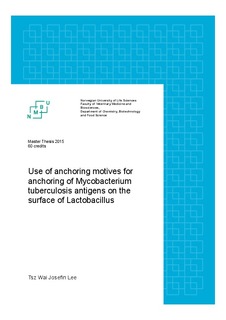| dc.description.abstract | This thesis describes the work that was done to investigate the use of L. plantarum WCFS1 as a live delivery vehicle for the delivery of the M. tuberculosis fusion antigen TB10.4-HspX (TH) that is C-terminal fused with a dendritic cell binding peptide (DC-seq). The fusion antigen TH has been shown to elicit immune response from tuberculosis patients with active and latent tuberculosis infection, making the fusion antigen a promising candidate as a multistage vaccine against tuberculosis. The coupling to the DC-seq may enhance the immune response by potentially increasing uptake by dendritic cells. Lactic acid bacteria (LAB) are commonly used in food production, abundant in the environment and are a natural inhabitant in the human gastro-intestinal tract (GIT). These characteristics and their status as “generally regarded as safe” (GRAS), make LAB attractive candidates as oral delivery vehicles for biomolecules to mucosal sites. L. plantarum WCFS’s ability to survive passage through stomach and in the GIT for more than six days in its active form, make this bacterium well suited as an oral delivery vehicle.
Two non-GM approaches and one GM approach have been conducted in this study. In the non-GM approaches, TH_DC-seq and TH_DC-seq fused to a peptidoglycan binding LysM-anchor was produced intracellularly in E. coli or in L. plantarum WCFS1 with subsequent extraction and binding to wild type L. plantarum WCFS1. Getting adequate amounts of soluble fusion proteins for purification turned out to be challenging and thus, binding assays were done using the soluble fraction since no purified extracts were obtained. Both LysM_TH_DC-seq and TH_DC-seq seemed to be able to bind to L. plantarum WCFS1.
In the GM approach, TH_DC-seq was constructed for direct display on the cell surface of recombinant L. plantarum WCFS1 using three different anchors (LysM-anchor, LPxTG- anchor and lipobox-anchor). Production was confirmed except in the case of TH_DC-seq that was coupled to the LPxTG-anchor. Correct anchoring could not be confirmed, as fusion proteins on the cell surface of live cells could not be detected.
In conclusion, this study shows that production of TH_DC-seq is possible in both E. coli and L. plantarum WCFS1. Binding assays indicate that using L. plantarum WCFS1 as delivery vehicle for TH_DC-seq is a promising strategy for development of a novel vaccine against tuberculosis.
SAMMENDRAG
Oppgaven omhandler forsøk gjort for å undersøke bruk av L. Plantarum WCFS1 som levende vektor for levering av M. tuberculosis fusjonsantigenet TB10.4-HspX (TH) som er C- terminalt fusert til et peptid (DC-seq) med affinitet for dendrittiske celler. Det er blitt vist at fusjonsantigenet TH kan initiere immunrespons hos tuberkulosepasienter med aktiv eller latent infeksjon, noe som gjøre TH til en lovende kandidat for utvikling av en multifasevaksine mot tuberkulose. Fusering til DC-seq kan forsterke immunresponsen ved å potensielt øke opptak av fusjonsantigenet av dendrittiske celler. Melkesyrebakterier er ofte brukt i matproduksjon, vanlig å finne i miljøet og er en del av den naturlige floraen i det humane fordøyelsessystemet. Disse karaktertrekkene og deres status som ”generally regarded as safe” (GRAS), gjør melkesyrebakteriene til gode kandidater som leveringsvektorer for oral levering av biomolekyler via slimhinner. L. Plantarum WCFS1 er velegnet som en oral leveringsvektor fordi bakterien kan overleve passeringen forbi magesekken og i mer enn seks dager i mage-tarm-kanalen.
To ikke-genmodifiserte tilnærminger og én genmodifisert tilnærming har blitt utført i dette prosjektet. I de ikke-genmodifiserte tilnærmingene ble TH_DC-seq og TH_DC-seq fusert til et peptidoglykanbindene LysM-anker, produsert i E. coli eller L. plantarum WCFS1. Produseringen etterfølges av proteinekstraksjon og bindingsekperiment til villtype L. plantarum WCFS1. Å få tilstrekkelig mengde av løselig fusjonsprotein til rensing viste seg å være vanskelig, dermed ble bindingsstudiene utført med den løselige fraksjonen ettersom ingen renset ekstrakt kunne anskaffes. Både LysM_TH_DC-seq og TH_DC-seq synes å kunne binde seg til L. plantarum WCFS1.
I den genmodifiserte tilnærmingen ble TH_DC-seq konstruert til å bli direkte forankret på celleoverflaten til rekombinant L. plantarum WCFS1 ved hjelp av tre ulike anker (et LysM-anker, et LPxTG-anker og et lipoboks-anker). Produksjon av disse fusjonsproteinene var bekreftet, med unntak av TH_DC-seq som var fusert med LPxTG-ankeret. Riktig forankring på celleoverflaten kunne ikke bli bekreftet da fusjonsproteinene kunne ikke bli detektert på celleoverflaten av levende celler.
I konklusjon kan man med arbeidet gjort i dette prosjektet vise at det er mulig å produsere TH_DC-seq med både E. coli og L. plantarum WCFS1. Bindingsstudiene viser at bruk av L. plantarum WCFS1 som leveringsvektor av TH_DC-seq er en lovende strategi for utvikling av en ny tuberkulosevaksine. | nb_NO |

